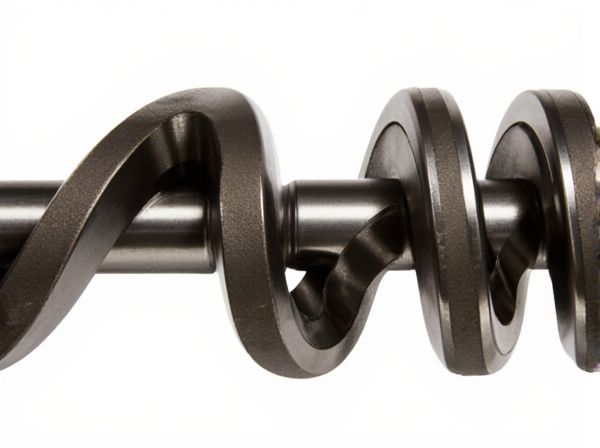
Photo illustration: Knife-Edge Crankshaft vs Standard Counterweight Crankshaft
Knife-edge crankshafts offer reduced rotational mass, improving engine responsiveness and acceleration compared to standard counterweight crankshafts. Standard counterweight crankshafts are designed to balance engine forces, minimizing vibrations and enhancing durability. Your choice depends on whether you prioritize performance gains or long-term reliability in engine operation.
Table of Comparison
| Feature | Knife-Edge Crankshaft | Standard Counterweight Crankshaft |
|---|---|---|
| Design Type | Precision-machined, sharp edges | Heavier, balanced with counterweights |
| Weight | Lightweight for reduced rotational mass | Heavier due to integrated counterweights |
| Performance | Improved engine response and higher RPM capability | Stable operation with reduced vibration |
| Durability | More susceptible to stress concentration | Better durability under heavy loads |
| Applications | High-performance and racing engines | Standard production and daily-driven vehicles |
| Cost | Higher manufacturing cost due to precision | Lower cost, mass-produced |
Introduction to Crankshaft Designs
Knife-edge crankshafts feature narrow, sharp counterweights designed to reduce windage and rotational mass, enhancing engine response and high-speed performance. Standard counterweight crankshafts have broader, more substantial weights that promote smoother operation and improved balance, reducing vibration in lower RPM ranges. Selecting between these designs depends on specific engine requirements, balancing performance gains with durability and ride comfort.
What is a Knife-Edge Crankshaft?
A knife-edge crankshaft features counterweights with sharp, thin edges designed to reduce windage and rotational mass, enhancing engine responsiveness and high-RPM performance. Its streamlined design minimizes air resistance and allows for quicker acceleration compared to standard counterweight crankshafts, which have bulkier, rounded counterweights primarily focused on balancing. Typically favored in racing engines and high-performance applications, knife-edge crankshafts improve throttle response and overall engine efficiency by optimizing rotational dynamics.
Understanding Standard Counterweight Crankshafts
Standard counterweight crankshafts are engineered to balance engine vibrations and reduce stress on the crankshaft by incorporating strategically placed counterweights opposite the crank pins. These counterweights counteract the reciprocating mass of the pistons and connecting rods, enhancing engine smoothness and longevity. The design prioritizes durability and vibration reduction, making it suitable for most production engines where reliability outweighs minimal weight savings.
Performance Benefits of Knife-Edge Crankshafts
Knife-edge crankshafts offer superior balance and reduced rotational mass compared to standard counterweight crankshafts, resulting in quicker engine response and higher RPM capabilities. The precise machining of the knife-edge design minimizes windage losses, improving overall mechanical efficiency and power output. Enhanced durability under high-stress conditions allows knife-edge crankshafts to maintain optimal performance in racing and high-performance engines.
Advantages of Standard Counterweight Designs
Standard counterweight crankshafts enhance engine balance by effectively counteracting the inertia forces generated by the rotating and reciprocating components, reducing vibrations and promoting smoother operation. Their design improves durability by distributing stress more evenly across the crankshaft, which minimizes wear and potential fatigue failures in high-performance or heavy-duty engines. Enhanced stability and reduced harmonic imbalances contribute to improved engine efficiency and longevity compared to knife-edge crankshaft configurations.
Engine Response: Knife-Edge vs Standard Counterweight
Knife-edge crankshafts enhance engine response by minimizing rotational mass, allowing quicker acceleration and more precise throttle control compared to standard counterweight crankshafts. Standard counterweight crankshafts focus on balancing and reducing vibrations, which can slightly compromise rapid engine acceleration and throttle responsiveness. The reduced inertia in knife-edge designs results in improved transient engine performance, making them ideal for high-performance and racing applications.
Durability and Longevity Considerations
Knife-edge crankshafts offer enhanced durability due to reduced rotational inertia and lower stress concentrations, resulting in improved resistance to fatigue and wear compared to standard counterweight crankshafts. Standard counterweight crankshafts provide greater balance and smoother operation but may experience accelerated wear at bearing surfaces under high-load conditions, potentially reducing longevity. Engine applications demanding high RPM and rapid acceleration benefit from knife-edge designs, while those prioritizing consistent performance and vibration damping may favor standard counterweight crankshafts for longer service life.
Impact on Engine Balancing and Vibration
Knife-edge crankshafts offer enhanced engine balancing by reducing rotational inertia and minimizing vibration through precise mass distribution along the crankpin, improving high-RPM stability and responsiveness. Standard counterweight crankshafts rely on larger, heavier counterweights to offset reciprocating mass, which effectively dampens low-frequency vibrations but can increase overall engine weight and rotational drag. The knife-edge design optimizes dynamic balance, promoting smoother operation and increased efficiency in performance engines, whereas counterweight crankshafts prioritize durability and vibration control in more conventional powertrains.
Applications: Which Crankshaft for Which Engine?
Knife-edge crankshafts are primarily used in high-performance racing engines due to their reduced weight and ability to minimize rotational inertia, enhancing engine responsiveness and acceleration. Standard counterweight crankshafts are suitable for everyday automotive engines and heavy-duty applications where balance and vibration reduction are critical for longevity and smooth operation. Selecting the ideal crankshaft depends on the engine's intended use: knife-edge for high RPM and performance demands, and counterweight designs for durability and balanced performance in regular driving conditions.
Choosing the Right Crankshaft for Your Build
Knife-edge crankshafts offer reduced rotational mass and improved throttle response, making them ideal for high-performance, naturally aspirated engines requiring quick revving capabilities. Standard counterweight crankshafts provide better overall balance and durability, suited for street-driven builds where longevity and smooth operation under varying loads are priorities. Selecting the right crankshaft depends on your engine's intended use, balancing performance gains against reliability and stress tolerance.
 caratoz.com
caratoz.com